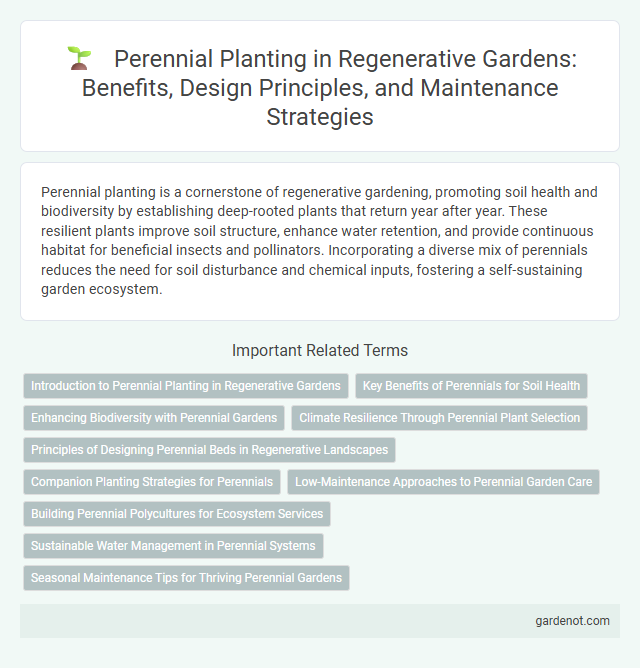Perennial planting is a cornerstone of regenerative gardening, promoting soil health and biodiversity by establishing deep-rooted plants that return year after year. These resilient plants improve soil structure, enhance water retention, and provide continuous habitat for beneficial insects and pollinators. Incorporating a diverse mix of perennials reduces the need for soil disturbance and chemical inputs, fostering a self-sustaining garden ecosystem.
Introduction to Perennial Planting in Regenerative Gardens
Perennial planting in regenerative gardens enhances soil health by promoting deep root systems that increase carbon sequestration and improve water retention. These plants contribute to biodiversity, creating habitats for beneficial insects and microorganisms essential for ecosystem balance. Selecting native perennial species ensures sustainability, resilience to local environmental conditions, and reduces the need for external inputs like fertilizers and pesticides.
Key Benefits of Perennials for Soil Health
Perennial plants enhance soil health by improving structure and increasing organic matter through deep-rooted systems that prevent erosion and promote aeration. Their extensive root networks support beneficial microbial activity and nutrient cycling, fostering a resilient soil ecosystem. Perennials reduce the need for frequent soil disturbance, maintaining soil integrity and boosting long-term fertility.
Enhancing Biodiversity with Perennial Gardens
Perennial planting significantly enhances biodiversity by providing stable habitats and continuous food sources for pollinators, birds, and beneficial insects throughout the year. Native perennial species contribute to soil health by supporting diverse microbial communities and reducing erosion, which promotes ecosystem resilience. Integrating a variety of perennial plants in garden design fosters ecological balance and supports long-term sustainability within regenerative gardening practices.
Climate Resilience Through Perennial Plant Selection
Perennial planting enhances climate resilience by promoting deep root systems that improve soil structure and water retention, reducing erosion and drought stress. Selecting native, drought-tolerant, and flood-resistant perennial species helps maintain biodiversity and ecosystem stability amid changing weather patterns. These durable plants require less maintenance and chemical input, supporting sustainable, regenerative garden practices crucial for long-term environmental health.
Principles of Designing Perennial Beds in Regenerative Landscapes
Designing perennial beds in regenerative landscapes involves selecting diverse, native plant species that promote soil health and biodiversity while requiring minimal irrigation. Emphasizing deep-rooted perennials enhances natural nutrient cycling and improves water retention, supporting resilient ecosystems. Strategic plant layering and companion planting optimize space, reduce pests, and foster symbiotic relationships within the garden.
Companion Planting Strategies for Perennials
Companion planting strategies for perennials enhance soil health and boost plant resilience by pairing complementary species such as legumes with nutrient-demanding plants to naturally fix nitrogen. Deep-rooted perennials improve soil structure and water infiltration, while ground-cover companions suppress weeds and retain moisture, creating a balanced micro-ecosystem. Strategic spatial arrangement of perennials supports beneficial insect habitats and promotes biodiversity, driving regenerative garden productivity.
Low-Maintenance Approaches to Perennial Garden Care
Perennial planting in regenerative gardens emphasizes low-maintenance approaches that enhance soil health and biodiversity while minimizing resource input. Strategies include mulching to retain moisture, selecting drought-tolerant native species, and employing organic compost to boost soil fertility naturally. These practices reduce the need for frequent watering, fertilization, and pest control, ensuring sustainable, resilient perennial garden ecosystems.
Building Perennial Polycultures for Ecosystem Services
Building perennial polycultures enhances soil health, promotes biodiversity, and supports pollinator populations by integrating diverse, long-lived plant species that interact symbiotically. These complex planting designs improve nutrient cycling, increase carbon sequestration, and stabilize microclimates, creating resilient ecosystems that provide essential services year-round. Implementing perennial systems reduces the need for chemical inputs, boosts natural pest control, and fosters sustainable water management within regenerative gardens.
Sustainable Water Management in Perennial Systems
Perennial planting systems enhance sustainable water management by promoting deep root structures that improve soil infiltration and reduce surface runoff. These root systems increase soil organic matter and water retention capacity, decreasing the need for supplemental irrigation. Integrating drought-tolerant perennials and mulching techniques further conserves moisture, supporting long-term ecosystem resilience in regenerative gardens.
Seasonal Maintenance Tips for Thriving Perennial Gardens
Perennial planting requires careful seasonal maintenance to ensure vibrant growth and longevity, including timely pruning, mulching, and soil amendment to support root health throughout changing weather conditions. Regular inspection for pests and diseases combined with appropriate watering schedules tailored to seasonal rainfall patterns enhances plant resilience and flowering quality. Incorporating organic matter in fall and strategic division of overcrowded perennials in early spring optimizes nutrient availability and promotes vigorous seasonal blooms.
Perennial planting Infographic

 gardenot.com
gardenot.com